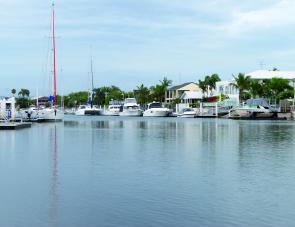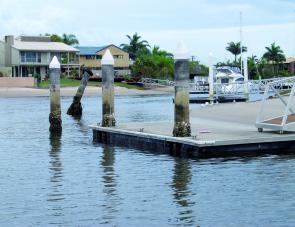If you haven’t read any of the previous two articles in this series, I’m showing how to target fish at different structures that can be found anywhere. Don’t worry about if these exact pieces of structure aren’t at your place, all you need in your area is something similar for this article to be of benefit.
Your local marina and its associated jetties, canals, boats and pontoons have to be one of the best areas that you can target bream. There’s one in nearly every coastal town in the country these days.
Although bream are the main target species, fish other than bream call this diverse structure home too. Trevally, jacks, Moses perch and cod, to name a few, will all hit your lure as you work in amongst this tangle of boats and pylons.
If you like to target pontoons then nearly every house in every canal system has one, and the saying ‘no run no fun’ holds true in many situations. However, in canals there’s never much run at any time but the fish don’t seem to mind the lack of water movement.
I find the state of the tide has a bigger influence on whether the fish are going to be co-operative. The tide from half out to the bottom and back to half-flood are the hardest for me to catch fish under most boats and pontoons in canals. This is because there is very little water under the structure at this time so the fish have gone to greener pastures. If you happen to find something that has a deep hole under it, then that’s definitely worth a few casts.
As the tide floods and fills the canal, you can get 1-1.5m of water under the boat or pontoon and the fish will begin to fire up.
Two of the biggest secrets to success with this type of fishing are the ability to produce long accurate casts and to have an electric motor. Without them, your odds of catching bream are very slender. Likewise, canals by their very nature are quiet waterways. Noise, be it engine noise, thumping and banging about in the boat, will shut canal fish down real fast. So be as silent as possible.
My other tip is to fish as light as possible with your plastic. Many times you will see fish swirls or the actual fish feeding on the structure right on the surface, if you use a heavy head it will sink too fast past the fish and the loud plonk as it lands on the water will spook the fish. So a long cast with a lightly weighted plastic will quadruple your chances of a strike. I like to use 0.5g or lighter heads with 2-3” plastics. These lightweight rigs make them easy to skip cast in under gapped pontoons.
Boats attached to pontoons work well if you can get your lure way up in between the boat and the pontoon. That quiet, dark water nearly always holds a fish. Targeting the open side of the boat rarely works for me.
Approaching a pontoon, place your first cast to the rear corner of it where the pylon attaches to the pontoon. Always cast to the shade side. As your offering sinks down a foot or so, give your rod tip a tiny twitch and then let the lure continue on its way to the bottom. Often after that little twitch of the plastic, you’ll get a hit.
If it reaches the bottom without a hit, slowly work your lure back to the boat using a slow lift of the rod tip for 20-30cm then give the tip another little flick to impart some action to the plastic before letting it sink back to the bottom. A hit, when it comes, will normally be as your lure slowly sinks back to the bottom. If you don’t get any action from the back of the pontoon, fan your casts to the sides and front and if possible underneath.
The go-to plastics for me in the clear water are the 2” Gulp Shrimp in moulting colour, the 3” Berkley minnow in pearl watermelon colour and the 2” Kokoda K-grub, green colour. Use very lightweight heads, or the HWS (hidden weight system) hooks in 1/24oz. The wind tends to be the governing factor as to what weight jighead to use in most canal systems.
If the water is murky or dirty, use the same heads but change the plastics to darker colours. Go to a new penny shrimp, a pumpkinseed coloured minnow or a 70-85mm Squidgy Flickbait in flash prawn. Small hardbodies, like the Rebel Teeny Wee Crawdads, work well at times and are great for working down the side of a boat hull. But for versatility you can’t go past a plastic in the canals.
For canal luring, it is a skill of finesse, accuracy and stealth.
Reads: 2248






